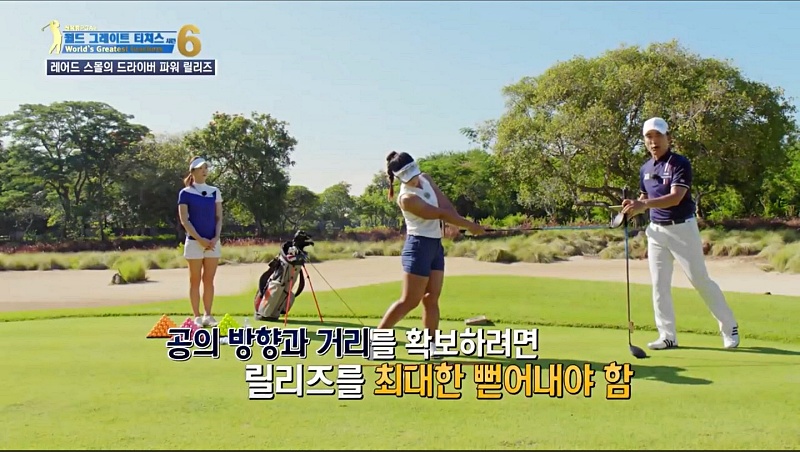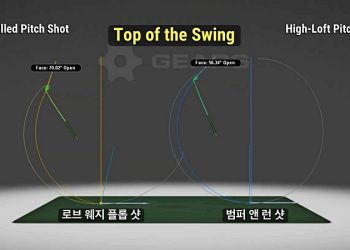파워 스윙을 위해서 릴리스는 중요하다. 드라이버 샷에서 파워 릴리스란 스윙 중 골퍼가 손목의 코킹 각도를 풀면서 클럽 헤드가 볼과의 임팩트를 통해 가속할 수 있도록 하는 순간이다. 이는 거리와 정확도를 극대화하는 데 절대적으로 필요하다. 그래서 릴리스와 샷 비거리 간의 관계를 이해할 필요가 있다.
레어드스몰은 탑에서 내려올 때 코킹이 풀리는 위치로 릴리스의 3가지 유형을 이야기한다. 첫째, 톰 왓슨과 어니 엘스는 백스윙을 한 뒤 탑 바로 아랫부분에서 릴리스를 시작한다. 조금 일찍 릴리스하기 때문에 스윙의 반지름 길이가 다른 사람보다 길다.
둘째, 타이거 우즈의 경우다. 그는 다운스윙할 때 최대한 손목의 각도를 유지하면서 내려와 양손이 오른쪽 허벅지 위치에 도달할 때 릴리스를 시작한다.
세 번째는 벤 호건과 샘 스니드다. 이들은 다운스윙 때 손목의 각도를 최대한 유지하다가 볼 바로 뒤에서 릴리스를 시작한다.

이 세 가지 릴리스의 방법 모두 스윙에 좋은 영향을 미친다. 위에 소개한 선수들은 메이저 챔피언십에서 우승했으며 많은 시간을 투자해서 이러한 동작을 만들어냈다. 골퍼들이 알아야 할 것은 얼마나 오랜 시간 동안 스윙이 만들어져 왔으며 이 스윙이 실제 경기 때 어떻게 발휘되었는가 하는 것이다. 그리고 심한 압박 상태에서 잘 이겨내는 방법도 알아둘 필요가 있다.
먼저 이러한 릴리스 동작을 위한 기본은 손의 악력에서 시작된다. 클럽을 위로 들어서 헤드의 무게가 그립으로 내려오기 때문에 헤드의 무게를 잘 느낄 수 없다. 하지만 클럽을 아래로 내리면 중력의 영향으로 클럽을 강하게 잡게 된다. 이렇게 너무 강하게 잡게 되면 연결성 있는 스윙을 할 수가 없다. 골퍼에게 가장 적합한 그립은 클럽을 45도로 들었을 때 헤드의 무게도 느낄 수 있는 적절한 그립의 강도가 최적이다.
발표된 논문들에 의하면, 그립 강도가 부족한 골퍼는 스윙 속도와 비거리에서 결함을 보이는 경향이 있다고 한다. 강한 그립은 클럽헤드 스피드를 증가시킨다. 더 멀리 볼을 보내기 위해서 필요하고 비거리로 연결된다.
프로 골퍼들은 일반적으로 스윙 시작 시 4~6/10의 그립 강도를 유지한다. 임팩트 순간에는 10/10으로 증가시킨다. 이는 손과 팔의 힘이 클럽을 제어하는 데 얼마나 중요한지를 보여준다.
또 긴장 상태를 벗어나야 릴리스 동작에서 최고의 효과를 만들 수 있다. 정상급 투어 프로들의 스윙을 보면 긴장감에서 많이 벗어난 것처럼 보인다. 그들은 대개 볼을 치고 난 후에 클럽을 내리고 가볍게 양팔을 흔든다. 강한 압박감에서 스윙의 연결성을 이어가려는 방법인 것이다.
볼을 멀리 똑바로 치기 위한 릴리스의 결론은 적절한 타이밍을 가져야 한다. 너무 이르거나 너무 늦지 않게 골퍼가 임팩트 시 최적의 클럽헤드 스피드를 달성할 수 있도록 해야 한다. 특정 연습을 통해 손목 메커니즘에 집중함으로써 골퍼는 릴리스 타이밍을 자신에게 적합하고 익숙하게 되도록 반복 연습을 가져야 한다.
☞ 전욱휴는…
서울대 졸업 후 미국에 유학, 1996년 PGA 클래스A 프로가 됐다. 이후 28년만인 2024년 전세계 골프계 최고 권위의 ‘PGA 마스터 프로페셔널’ 자격을 획득했다. SBS, MBC, JTBC, YTN 등의 골프 채널 진행자 및 해설자로 활약했고, 지금은 애틀랜타와 한국을 오가며 골프 레슨 및 골프 관련 비즈니스를 하고 있다. chungolf@gmail.com
[Dr.Eric Chun’s Golf Lesson] 37. 30 Yards Further: The Power Release!
Grip Pressure: Soft at Address, Strong at Impact
What is the Power Release in a Driver Shot?
The release is crucial for a powerful swing. It’s the moment during the swing when a golfer unleashes the cocked wrist angle, allowing the clubhead to accelerate through impact with the ball. This is absolutely essential for maximizing distance and accuracy. Therefore, it’s necessary to understand the relationship between release and shot distance.
Laird Small describes three types of release based on the position where the cocking is released when coming down from the top:
1. Tom Watson and Ernie Els, for example, start their release in this area (just below the top) during the backswing. Because they release a bit early, their swing radius is longer than others.
2. Tiger Woods’ case is different. During the downswing, he maintains the wrist angle as much as possible and starts the release when both hands reach the position of the right thigh.
3. Ben Hogan and Sam Snead’s release: They maintain the wrist angle as much as possible during the downswing and start the release just behind the ball.
All three release methods have a positive impact on the swing. The players mentioned above have won major championships and invested a lot of time to develop these motions. Golfers need to understand how long it took to develop these swings and how they performed in competitions, especially under intense pressure.
The foundation for these motions starts with grip strength. When you lift the club up, you can’t feel the weight of the head well because it’s coming down to the grip. However, when you lower the club, you grip it strongly due to gravity. If you grip too tightly this way, you can’t make a connected swing. The optimal grip for a golfer is one where you can feel the weight of the head when the club is held at a 45-degree angle.
According to published papers, golfers with insufficient grip strength tend to show deficiencies in swing speed and distance. A strong grip increases clubhead speed. It’s necessary to send the ball further and translates into distance.
Professional golfers typically maintain a grip strength of 4-6/10 at the start of the swing. At the moment of impact, they increase it to 10/10. This shows how important the strength of hands and arms is in controlling the club.
The release motion of pros can achieve the best effect when free from tension. Tour pros at the top have their own practice methods. Their swings appear to be far from tense. After hitting the ball, they gently swing both arms down. This is a method to maintain swing connectivity under strong pressure.
The conclusion for a release to hit the ball far and straight is to have the right timing. The golfer should achieve optimal clubhead speed at impact, neither too early nor too late. Through specific practice focusing on wrist mechanics, golfers should repeat exercises to make the release timing suitable and familiar to themselves.




![[전욱휴의 골프레슨] 37. 30야드 더, 파워 릴리스](https://www.atlantajoongang.com/wp-content/uploads/2024/12/ZzKakaoTalk_20241212_070553874_01-750x420.jpg)

















![[전욱휴의 골프 레슨] 46. 배치기(얼리 익스텐션)](https://www.atlantajoongang.com/wp-content/uploads/2025/03/photoKakaoTalk_20250306_073237889_01-350x250.jpg?v=1741361116)
![[전욱휴의 골프 레슨] 45. 임성재 '행온페이드' 샷](https://www.atlantajoongang.com/wp-content/uploads/2025/02/collage1-350x250.jpg)
![[전욱휴의 골프레슨] 44. 일관된 샷을 원한다면](https://www.atlantajoongang.com/wp-content/uploads/2025/02/QKakaoTalk_20250212_065748485-350x250.jpg)

![[전욱휴 골프 레슨] 42. 오른쪽 팔꿈치 역할](https://www.atlantajoongang.com/wp-content/uploads/2025/01/qQ1KakaoTalk_20250130_072058648-350x250.jpg)
![[전욱휴의 골프 레슨] 41. 매킬로이 파워 스윙](https://www.atlantajoongang.com/wp-content/uploads/2025/01/qQ1KakaoTalk_20250122_123635940-350x250.jpg)
